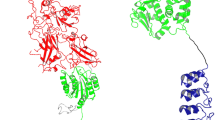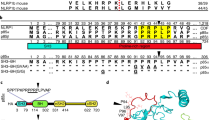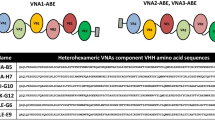Abstract
Anthrax toxin protective antigen (PrAg) forms a heptamer in which the binding site for lethal factor (LF) spans two adjacent monomers1,2. This suggested that high cell-type specificity in tumor targeting could be obtained using monomers that generate functional LF-binding sites only through intermolecular complementation. We created PrAg mutants with mutations affecting different LF-binding subsites and containing either urokinase plasminogen activator (uPA) or matrix metalloproteinase (MMP) cleavage sites. Individually, these PrAg mutants had low toxicity as a result of impaired LF binding, but when administered together to uPA- and MMP-expressing tumor cells, they assembled into functional LF-binding heteroheptamers. The mixture of two complementing PrAg variants had greatly reduced toxicity in mice and was highly effective in the treatment of aggressive transplanted tumors of diverse origin. These results show that anthrax toxin, and by implication other multimeric toxins, offer excellent opportunities to introduce multiple-specificity determinants and thereby achieve high therapeutic indices.
This is a preview of subscription content, access via your institution
Access options
Subscribe to this journal
Receive 12 print issues and online access
$209.00 per year
only $17.42 per issue
Buy this article
- Purchase on Springer Link
- Instant access to full article PDF
Prices may be subject to local taxes which are calculated during checkout




Similar content being viewed by others
References
Mogridge, J., Cunningham, K., Lacy, D.B., Mourez, M. & Collier, R.J. The lethal and edema factors of anthrax toxin bind only to oligomeric forms of the protective antigen. Proc. Natl. Acad. Sci. USA 99, 7045–7048 (2002).
Cunningham, K., Lacy, D.B., Mogridge, J. & Collier, R.J. Mapping the lethal factor and edema factor binding sites on oligomeric anthrax protective antigen. Proc. Natl. Acad. Sci. USA 99, 7049–7053 (2002).
Liu, S., Schubert, R.L., Bugge, T.H. & Leppla, S.H. Anthrax toxin: structures, functions and tumour targeting. Expert Opin. Biol. Ther. 3, 843–853 (2003).
Bradley, K.A., Mogridge, J., Mourez, M., Collier, R.J. & Young, J.A. Identification of the cellular receptor for anthrax toxin. Nature 414, 225–229 (2001).
Scobie, H.M., Rainey, G.J., Bradley, K.A. & Young, J.A. Human capillary morphogenesis protein 2 functions as an anthrax toxin receptor. Proc. Natl. Acad. Sci. USA 100, 5170–5174 (2003).
Klimpel, K.R., Molloy, S.S., Thomas, G. & Leppla, S.H. Anthrax toxin protective antigen is activated by a cell-surface protease with the sequence specificity and catalytic properties of furin. Proc. Natl. Acad. Sci. USA 89, 10277–10281 (1992).
Petosa, C., Collier, R.J., Klimpel, K.R., Leppla, S.H. & Liddington, R.C. Crystal structure of the anthrax toxin protective antigen. Nature 385, 833–838 (1997).
Leppla, S.H. Anthrax toxin edema factor: a bacterial adenylate cyclase that increases cyclic AMP concentrations of eukaryotic cells. Proc. Natl. Acad. Sci. USA 79, 3162–3166 (1982).
Duesbery, N.S. et al. Proteolytic inactivation of MAP-kinase-kinase by anthrax lethal factor. Science 280, 734–737 (1998).
Liu, S., Netzel-Arnett, S., Birkedal-Hansen, H. & Leppla, S.H. Tumor cell-selective cytotoxicity of matrix metalloproteinase-activated anthrax toxin. Cancer Res. 60, 6061–6067 (2000).
Liu, S., Bugge, T.H. & Leppla, S.H. Targeting of tumor cells by cell surface urokinase plasminogen activator-dependent anthrax toxin. J. Biol. Chem. 276, 17976–17984 (2001).
Liu, S., Aaronson, H., Mitola, D.J., Leppla, S.H. & Bugge, T.H. Potent antitumor activity of a urokinase-activated engineered anthrax toxin. Proc. Natl. Acad. Sci. USA 100, 657–662 (2003).
Stetler-Stevenson, W.G., Aznavoorian, S. & Liotta, L.A. Tumor cell interactions with the extracellular matrix during invasion and metastasis. Annu. Rev. Cell Biol. 9, 541–573 (1993).
Dano, K. et al. Cancer invasion and tissue remodeling—cooperation of protease systems and cell types. APMIS 107, 120–127 (1999).
Andreasen, P.A., Egelund, R. & Petersen, H.H. The plasminogen activation system in tumor growth, invasion, and metastasis. Cell. Mol. Life Sci. 57, 25–40 (2000).
Arora, N. & Leppla, S.H. Residues 1–254 of anthrax toxin lethal factor are sufficient to cause cellular uptake of fused polypeptides. J. Biol. Chem. 268, 3334–3341 (1993).
Mogridge, J., Cunningham, K. & Collier, R.J. Stoichiometry of anthrax toxin complexes. Biochemistry 41, 1079–1082 (2002).
Malatynska, E. et al. Schild regression analysis of antidepressant and bicuculline antagonist effects at the GABAA receptor. Pharmacology 57, 117–123 (1998).
Varughese, M., Teixeira, A.V., Liu, S. & Leppla, S.H. Identification of a receptor-binding region within domain 4 of the protective antigen component of anthrax toxin. Infect. Immun. 67, 1860–1865 (1999).
Klimpel, K.R., Arora, N. & Leppla, S.H. Anthrax toxin lethal factor contains a zinc metalloprotease consensus sequence which is required for lethal toxin activity. Mol. Microbiol. 13, 1093–1100 (1994).
Puente, X.S., Sanchez, L.M., Overall, C.M. & Lopez-Otin, C. Human and mouse proteases: a comparative genomic approach. Nat. Rev. Genet. 4, 544–558 (2003).
Dhanasekaran, S.M. et al. Delineation of prognostic biomarkers in prostate cancer. Nature 412, 822–826 (2001).
Ullmann, R. et al. Protein expression profiles in adenocarcinomas and squamous cell carcinomas of the lung generated using tissue microarrays. J. Pathol. 203, 798–807 (2004).
Wasenius, V.M. et al. Hepatocyte growth factor receptor, matrix metalloproteinase-II, tissue inhibitor of metalloproteinase-I, and fibronectin are upregulated in papillary thyroid carcinoma: a cDNA and tissue microarray study. Clin. Cancer Res. 9, 68–75 (2003).
Hoang, C.D. et al. Gene expression profiling identifies matriptase overexpression in malignant mesothelioma. Chest 125, 1843–1852 (2004).
Kang, Y. et al. A multigenic program mediating breast cancer metastasis to bone. Cancer Cell 3, 537–549 (2003).
Coombs, G.S. et al. Substrate specificity of prostate-specific antigen (PSA). Chem. Biol. 5, 475–488 (1998).
Rosovitz, M.J. et al. Alanine scanning mutations in domain 4 of anthrax toxin protective antigen reveal residues important for binding to the cellular receptor and to a neutralizing monoclonal antibody. J Biol. Chem. 278, 30936–30944 (2003).
Liu, S. & Leppla, S.H. Cell surface tumor endothelium marker 8 cytoplasmic tail-independent anthrax toxin binding, proteolytic processing, oligomer formation, and internalization. J. Biol. Chem. 278, 5227–5234 (2003).
Geran, R.I., Greenberg, N.H., MacDonald, M.M., Schumacher, A.M. & Abbot, B.J. Protocols for screening chemical agents and natural products against animal tumors and other biological systems. Cancer Chemother. Rep. 3, 1–103 (1972).
Acknowledgements
We thank Dana Hsu for assistance with toxin purification.
Author information
Authors and Affiliations
Corresponding authors
Ethics declarations
Competing interests
The authors declare no competing financial interests.
Supplementary information
Supplementary Fig. 1
Toxicity of the engineered PrAg proteins. (PDF 853 kb)
Supplementary Table. 1
Properties and maximum tolerated doses of PrAg proteins when injected intraperitoneally at days 0, 3, and 6. (PDF 37 kb)
Rights and permissions
About this article
Cite this article
Liu, S., Redeye, V., Kuremsky, J. et al. Intermolecular complementation achieves high-specificity tumor targeting by anthrax toxin. Nat Biotechnol 23, 725–730 (2005). https://doi.org/10.1038/nbt1091
Received:
Accepted:
Published:
Issue Date:
DOI: https://doi.org/10.1038/nbt1091
This article is cited by
-
Cell surface–anchored serine proteases in cancer progression and metastasis
Cancer and Metastasis Reviews (2019)
-
An anthrax toxin variant with an improved activity in tumor targeting
Scientific Reports (2015)
-
Cytolethal distending toxin B as a cell-killing component of tumor-targeted anthrax toxin fusion proteins
Cell Death & Disease (2014)
-
Tumor therapy with a urokinase plasminogen activator-activated anthrax lethal toxin alone and in combination with paclitaxel
Investigational New Drugs (2013)
-
Urokinase-targeted recombinant bacterial protein toxins — a rationally designed and engineered anticancer agent for cancer therapy
Frontiers of Biology in China (2009)



